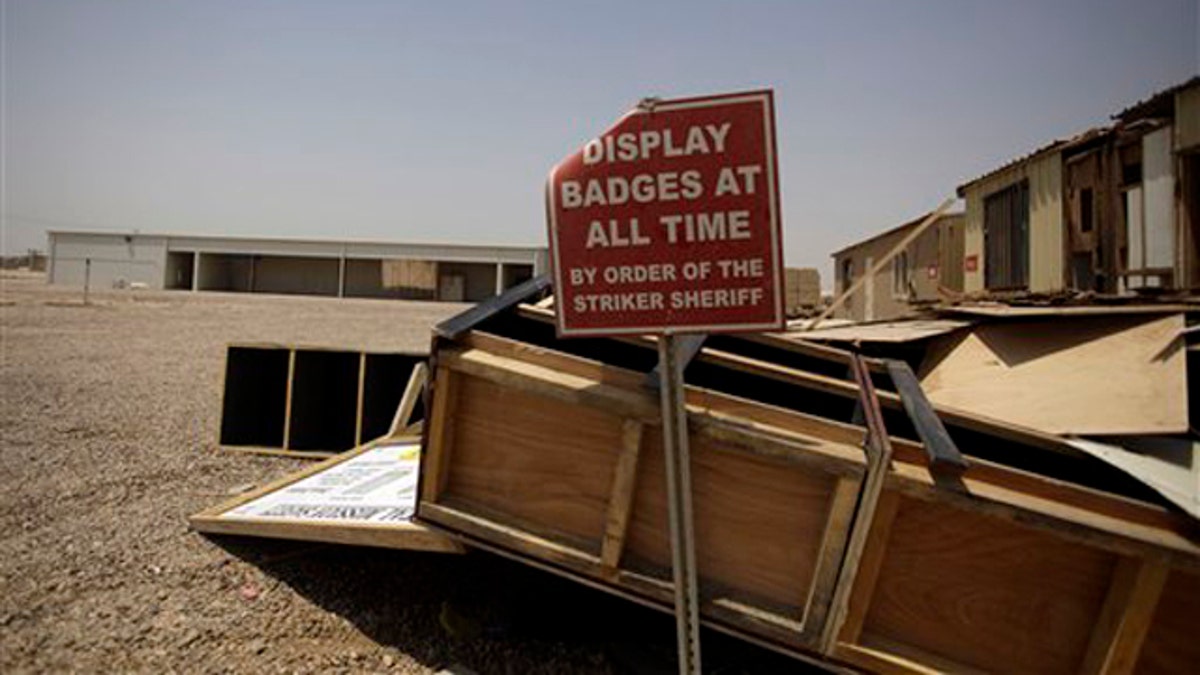
In this Aug. 4 photo, scraps of wood from the post office and a sign remain at a shuttered Camp Sather, part of the sprawling U.S. military Victory Base Complex that is set to close in Baghdad, Iraq. (AP)
Ten years and $60 billion in American taxpayer funds later, Iraq is still so unstable and broken that even its leaders question whether U.S. efforts to rebuild the war-torn nation were worth the cost.
In his final report to Congress, Special Inspector General for Iraq Reconstruction Stuart Bowen's conclusion was all too clear: Since the invasion a decade ago this month, the U.S. has spent too much money in Iraq for too few results.
The reconstruction effort "grew to a size much larger than was ever anticipated," Bowen told The Associated Press in a preview of his last audit of U.S. funds spent in Iraq, to be released Wednesday. "Not enough was accomplished for the size of the funds expended."
In interviews with Bowen, Prime Minister Nouri al-Maliki said the U.S. funding "could have brought great change in Iraq" but fell short too often. "There was misspending of money," said al-Maliki, a Shiite Muslim whose sect makes up about 60 percent of Iraq's population.
Iraqi Parliament Speaker Osama al-Nujaifi, the country's top Sunni Muslim official, told auditors that the rebuilding efforts "had unfavorable outcomes in general."
"You think if you throw money at a problem, you can fix it," Kurdish government official Qubad Talabani, son of Iraqi president Jalal Talabani, told auditors. "It was just not strategic thinking."
The abysmal Iraq results forecast what could happen in Afghanistan, where U.S. taxpayers have so far spent $90 billion in reconstruction projects during a 12-year military came seen a far more responsible approach to how the money was used, and lower levels of corruption in far fewer ways."
In numerous interviews with Iraqi and U.S. officials, and though multiple examples of thwarted or defrauded projects, Bowen's report laid bare a trail of waste, including:
--In Iraq's eastern Diyala province, a crossroads for Shiite militias, Sunni insurgents and Kurdish squatters, the U.S. began building a 3,600-bed prison in 2004 but abandoned the project after three years to flee a surge in violence. The half-completed Khan Bani Sa'ad Correctional Facility cost American taxpayers $40 million but sits in rubble, and Iraqi Justice Ministry officials say they have no plans to ever finish or use it.
--Subcontractors for Anham LLC, based in Vienna, Va., overcharged the U.S. government thousands of dollars for supplies, including $900 for a control switch valued at $7.05 and $80 for a piece of pipe that costs $1.41. Anham was hired to maintain and operate warehouses and supply centers near Baghdad's international airport and the Persian Gulf port at Umm Qasr.
-- A $108 million wastewater treatment center in the city of Fallujah, a former al-Qaida stronghold in western Iraq, will have taken eight years longer to build than planned when it is completed in 2014 and will only service 9,000 homes. Iraqi officials must provide an additional $87 million to hook up most of the rest of the city, or 25,000 additional homes.
--After blowing up the al-Fatah bridge in north-central Iraq during the invasion and severing a crucial oil and gas pipeline, U.S. officials decided to try to rebuild the pipeline under the Tigris River at a cost of $75 million. A geological study predicted the project might fail, and it did: Eventually, the bridge and pipelines were repaired at an additional cost of $29 million.
--A widespread ring of fraud led by ary Leon Panetta as saying that the 2011 withdrawal of American troops from Iraq weakened U.S. influence in Baghdad. Panetta has since left office when former Sen. Chuck Hagel took over the defense job last week. Washington is eyeing a similar military drawdown next year in Afghanistan, where U.S. taxpayers have spent $90 billion so far on rebuilding projects.
The Afghanistan effort risks falling into the same problems that mired Iraq if oversight isn't coordinated better. In Iraq, officials were too eager to build in the middle of a civil war, and too often raced ahead without solid plans or back-up plans, the report concluded.
Most of the work was done in piecemeal fashion, as no single government agency had responsibility for all of the money spent. The State Department, for example, was supposed to oversee reconstruction strategy starting in 2004, but controlled only about 10 percent of the money at stake. The vast majority of the projects -- 75 percent -- were paid for by the Defense Department.
























